Theory of tides
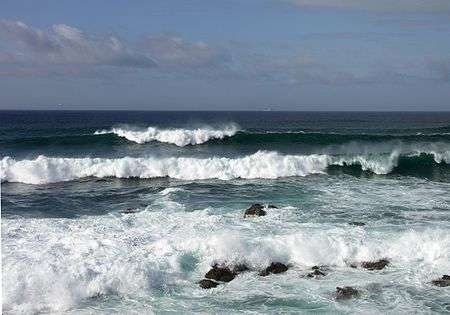
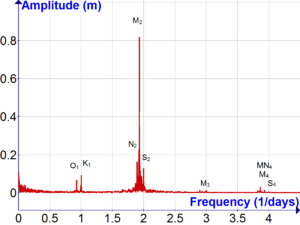
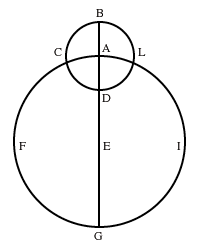
The theory of tides is the application of continuum mechanics to interpret and predict the tidal deformations of planetary and satellite bodies and their atmospheres and oceans (especially Earth's Ocean) under the gravitational loading of another astronomical body or bodies (especially the Moon).
Kepler
In 1609 Johannes Kepler correctly suggested that the gravitation of the Moon causes the tides,[1] basing his argument upon ancient observations and correlations. The influence of the Moon on tides was mentioned in Ptolemy's Tetrabiblos as having derived from ancient observation.
Galileo's attempt to explain the tides

In 1616, Galileo Galilei wrote Discourse on the Tides (Discorso sul flusso e il reflusso del mare),[2] in a letter to Cardinal Orsini. In this discourse, he tried to explain the occurrence of the tides as the result of the Earth's rotation and revolution around the Sun. Galileo believed that the oceans moved like water in a large basin: as the basin moves, so does the water.[3] Therefore, as the Earth revolves, the force of the Earth's rotation causes the oceans to "alternately accelerate and retardate".[4] His view on the oscillation and "alternately accelerated and retardated" motion of the Earth's rotation is a "dynamic process" that deviated from the previous dogma, which proposed "a process of expansion and contraction of seawater."[5] However, Galileo's theory was erroneous.[2] In subsequent centuries, further analysis led to the current tidal physics. Galileo rejected Kepler's explanation of the tides.
Newton
Newton, in the Principia, provided a correct explanation for the tidal force, which can be used to explain tides on a planet covered by a uniform ocean, but which takes no account of the distribution of the continents or ocean bathymetry.[6]
The dynamic theory of Laplace
The dynamic theory of tides describes and predicts the actual real behavior of ocean tides.[7]
While Newton explained the tides by describing the tide-generating forces and Bernoulli gave a description of the static reaction of the waters on Earth to the tidal potential, the dynamic theory of tides, developed by Pierre-Simon Laplace in 1775,[8][9] describes the ocean's real reaction to tidal forces.[10] Laplace's theory of ocean tides took into account friction, resonance and natural periods of ocean basins. It predicted the large amphidromic systems in the world's ocean basins and explains the oceanic tides that are actually observed.[11] The equilibrium theory, based on the gravitational gradient from the Sun and Moon but ignoring the Earth's rotation, the effects of continents, and other important effects, could not explain the real ocean tides.[12][13][14][15][16][17][18][19] Since measurements have confirmed the theory, many things have possible explanations now, like how the tides interact with deep sea ridges and chains of seamounts give rise to deep eddies that transport nutrients from the deep to the surface.[20] The equilibrium tide theory calculates the height of the tide wave of less than half a meter, while the dynamic theory explains why tides are up to 15 meters.[21] Satellite observations confirm the accuracy of the dynamic theory, and the tides worldwide are now measured to within a few centimeters.[22][23] Measurements from the CHAMP satellite closely match the models based on the TOPEX data.[24][25][26] Accurate models of tides worldwide are essential for research since the variations due to tides must be removed from measurements when calculating gravity and changes in sea levels.[27]
Laplace's tidal equations
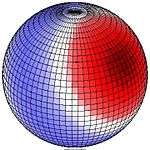 A. Lunar gravitational potential: this depicts the Moon directly over 30° N (or 30° S) viewed from above the Northern Hemisphere. |
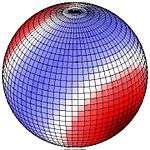 B. This view shows same potential from 180° from view A. Viewed from above the Northern Hemisphere. Red up, blue down. |
In 1776, Pierre-Simon Laplace formulated a single set of linear partial differential equations, for tidal flow described as a barotropic two-dimensional sheet flow. Coriolis effects are introduced as well as lateral forcing by gravity. Laplace obtained these equations by simplifying the fluid dynamic equations. But they can also be derived from energy integrals via Lagrange's equation.
For a fluid sheet of average thickness D, the vertical tidal elevation ς, as well as the horizontal velocity components u and v (in the latitude φ and longitude λ directions, respectively) satisfy Laplace's tidal equations:[28]
where Ω is the angular frequency of the planet's rotation, g is the planet's gravitational acceleration at the mean ocean surface, a is the planetary radius, and U is the external gravitational tidal-forcing potential.
William Thomson (Lord Kelvin) rewrote Laplace's momentum terms using the curl to find an equation for vorticity. Under certain conditions this can be further rewritten as a conservation of vorticity.
Tidal analysis and prediction
Harmonic analysis
Laplace's improvements in theory were substantial, but they still left prediction in an approximate state. This position changed in the 1860s when the local circumstances of tidal phenomena were more fully brought into account by William Thomson's application of Fourier analysis to the tidal motions as harmonic analysis.
Thomson's work in this field was then further developed and extended by George Darwin, applying the lunar theory current in his time. Darwin's symbols for the tidal harmonic constituents are still used.
Darwin's harmonic developments of the tide-generating forces were later improved when A T Doodson, applying the lunar theory of E W Brown,[29] developed the tide-generating potential (TGP) in harmonic form, distinguishing 388 tidal frequencies.[30] Doodson's work was carried out and published in 1921.[31]
Doodson devised a practical system for specifying the different harmonic components of the tide-generating potential, the Doodson numbers, a system still in use.[32]
Since the mid-twentieth century further analysis has generated many more terms than Doodson's 388. About 62 constituents are of sufficient size to be considered for possible use in marine tide prediction, but sometimes many fewer can predict tides to useful accuracy. The calculations of tide predictions using the harmonic constituents are laborious, and from the 1870s to about the 1960s they were carried out using a mechanical tide-predicting machine, a special-purpose form of analog computer now superseded in this work by digital electronic computers that can be programmed to carry out the same computations.
Tidal constituents
Tidal constituents combine to give an endlessly varying aggregate because of their different and incommensurable frequencies: the effect is visualized in an animation of the American Mathematical Society illustrating the way in which the components used to be mechanically combined in the tide-predicting machine. Amplitudes of tidal constituents are given below for six example locations: Eastport, Maine (ME),[33] Biloxi, Mississippi (MS), San Juan, Puerto Rico (PR), Kodiak, Alaska (AK), San Francisco, California (CA), and Hilo, Hawaii (HI).
|
Darwin |
Period |
Speed |
Doodson coefficients |
Doodson |
Amplitude at example location (cm) |
NOAA | |||||||||
|
Species |
Symbol |
(hr) |
rate(°/hr) |
n1 (L) | n2 (m) | n3 (y) | n4 (mp) |
number |
ME |
MS |
PR |
AK |
CA |
HI |
order |
| Shallow water overtides of principal lunar | M4 | 6.210300601 | 57.9682084 | 4 | 455.555 | 6.0 | 0.6 | 0.9 | 2.3 | 5 | |||||
| Shallow water overtides of principal lunar | M6 | 4.140200401 | 86.9523127 | 6 | 655.555 | 5.1 | 0.1 | 1.0 | 7 | ||||||
| Shallow water terdiurnal | MK3 | 8.177140247 | 44.0251729 | 3 | 1 | 365.555 | 0.5 | 1.9 | 8 | ||||||
| Shallow water overtides of principal solar | S4 | 6 | 60 | 4 | 4 | -4 | 491.555 | 0.1 | 9 | ||||||
| Shallow water quarter diurnal | MN4 | 6.269173724 | 57.4238337 | 4 | -1 | 1 | 445.655 | 2.3 | 0.3 | 0.9 | 10 | ||||
| Shallow water overtides of principal solar | S6 | 4 | 90 | 6 | 6 | -6 | * | 0.1 | 12 | ||||||
| Lunar terdiurnal | M3 | 8.280400802 | 43.4761563 | 3 | 355.555 | 0.5 | 32 | ||||||||
| Shallow water terdiurnal | 2"MK3 | 8.38630265 | 42.9271398 | 3 | -1 | 345.555 | 0.5 | 0.5 | 1.4 | 34 | |||||
| Shallow water eighth diurnal | M8 | 3.105150301 | 115.9364166 | 8 | 855.555 | 0.5 | 0.1 | 36 | |||||||
| Shallow water quarter diurnal | MS4 | 6.103339275 | 58.9841042 | 4 | 2 | -2 | 473.555 | 1.8 | 0.6 | 1.0 | 37 | ||||
|
Darwin |
Period |
Speed |
Doodson coefficients |
Doodson |
Amplitude at example location (cm) |
NOAA | |||||||||
| Species |
Symbol |
(hr) |
(°/hr) |
n1 (L) | n2 (m) | n3 (y) | n4 (mp) |
number |
ME |
MS |
PR |
AK |
CA |
HI |
order |
| Principal lunar semidiurnal | M2 | 12.4206012 | 28.9841042 | 2 | 255.555 | 268.7 | 3.9 | 15.9 | 97.3 | 58.0 | 23.0 | 1 | |||
| Principal solar semidiurnal | S2 | 12 | 30 | 2 | 2 | -2 | 273.555 | 42.0 | 3.3 | 2.1 | 32.5 | 13.7 | 9.2 | 2 | |
| Larger lunar elliptic semidiurnal | N2 | 12.65834751 | 28.4397295 | 2 | -1 | 1 | 245.655 | 54.3 | 1.1 | 3.7 | 20.1 | 12.3 | 4.4 | 3 | |
| Larger lunar evectional | ν2 | 12.62600509 | 28.5125831 | 2 | -1 | 2 | -1 | 247.455 | 12.6 | 0.2 | 0.8 | 3.9 | 2.6 | 0.9 | 11 |
| Variational | MU2 | 12.8717576 | 27.9682084 | 2 | -2 | 2 | 237.555 | 2.0 | 0.1 | 0.5 | 2.2 | 0.7 | 0.8 | 13 | |
| Lunar elliptical semidiurnal second-order | 2"N2 | 12.90537297 | 27.8953548 | 2 | -2 | 2 | 235.755 | 6.5 | 0.1 | 0.5 | 2.4 | 1.4 | 0.6 | 14 | |
| Smaller lunar evectional | λ2 | 12.22177348 | 29.4556253 | 2 | 1 | -2 | 1 | 263.655 | 5.3 | 0.1 | 0.7 | 0.6 | 0.2 | 16 | |
| Larger solar elliptic | T2 | 12.01644934 | 29.9589333 | 2 | 2 | -3 | 272.555 | 3.7 | 0.2 | 0.1 | 1.9 | 0.9 | 0.6 | 27 | |
| Smaller solar elliptic | R2 | 11.98359564 | 30.0410667 | 2 | 2 | -1 | 274.555 | 0.9 | 0.2 | 0.1 | 0.1 | 28 | |||
| Shallow water semidiurnal | 2SM2 | 11.60695157 | 31.0158958 | 2 | 4 | -4 | 291.555 | 0.5 | 31 | ||||||
| Smaller lunar elliptic semidiurnal | L2 | 12.19162085 | 29.5284789 | 2 | 1 | -1 | 265.455 | 13.5 | 0.1 | 0.5 | 2.4 | 1.6 | 0.5 | 33 | |
| Lunisolar semidiurnal | K2 | 11.96723606 | 30.0821373 | 2 | 2 | 275.555 | 11.6 | 0.9 | 0.6 | 9.0 | 4.0 | 2.8 | 35 | ||
|
Darwin |
Period |
Speed |
Doodson coefficients |
Doodson |
Amplitude at example location (cm) |
NOAA | |||||||||
| Species |
Symbol |
(hr) |
(°/hr) |
n1 (L) | n2 (m) | n3 (y) | n4 (mp) |
number |
ME |
MS |
PR |
AK |
CA |
HI |
order |
| Lunar diurnal | K1 | 23.93447213 | 15.0410686 | 1 | 1 | 165.555 | 15.6 | 16.2 | 9.0 | 39.8 | 36.8 | 16.7 | 4 | ||
| Lunar diurnal | O1 | 25.81933871 | 13.9430356 | 1 | -1 | 145.555 | 11.9 | 16.9 | 7.7 | 25.9 | 23.0 | 9.2 | 6 | ||
| Lunar diurnal | OO1 | 22.30608083 | 16.1391017 | 1 | 3 | 185.555 | 0.5 | 0.7 | 0.4 | 1.2 | 1.1 | 0.7 | 15 | ||
| Solar diurnal | S1 | 24 | 15 | 1 | 1 | -1 | 164.555 | 1.0 | 0.5 | 1.2 | 0.7 | 0.3 | 17 | ||
| Smaller lunar elliptic diurnal | M1 | 24.84120241 | 14.4920521 | 1 | 155.555 | 0.6 | 1.2 | 0.5 | 1.4 | 1.1 | 0.5 | 18 | |||
| Smaller lunar elliptic diurnal | J1 | 23.09848146 | 15.5854433 | 1 | 2 | -1 | 175.455 | 0.9 | 1.3 | 0.6 | 2.3 | 1.9 | 1.1 | 19 | |
| Larger lunar evectional diurnal | ρ | 26.72305326 | 13.4715145 | 1 | -2 | 2 | -1 | 137.455 | 0.3 | 0.6 | 0.3 | 0.9 | 0.9 | 0.3 | 25 |
| Larger lunar elliptic diurnal | Q1 | 26.868350 | 13.3986609 | 1 | -2 | 1 | 135.655 | 2.0 | 3.3 | 1.4 | 4.7 | 4.0 | 1.6 | 26 | |
| Larger elliptic diurnal | 2Q1 | 28.00621204 | 12.8542862 | 1 | -3 | 2 | 125.755 | 0.3 | 0.4 | 0.2 | 0.7 | 0.4 | 0.2 | 29 | |
| Solar diurnal | P1 | 24.06588766 | 14.9589314 | 1 | 1 | -2 | 163.555 | 5.2 | 5.4 | 2.9 | 12.6 | 11.6 | 5.1 | 30 | |
|
Darwin |
Period |
Speed |
Doodson coefficients |
Doodson |
Amplitude at example location (cm) |
NOAA | |||||||||
| Species |
Symbol |
(hr) |
(°/hr) |
n1 (L) | n2 (m) | n3 (y) | n4 (mp) |
number |
ME |
MS |
PR |
AK |
CA |
HI |
order |
| Lunar monthly | Mm | 661.3111655 | 0.5443747 | 0 | 1 | -1 | 65.455 | 0.7 | 1.9 | 20 | |||||
| Solar semiannual | Ssa | 4383.076325 | 0.0821373 | 0 | 2 | 57.555 | 1.6 | 2.1 | 1.5 | 3.9 | 21 | ||||
| Solar annual | Sa | 8766.15265 | 0.0410686 | 0 | 1 | 56.555 | 5.5 | 7.8 | 3.8 | 4.3 | 22 | ||||
| Lunisolar synodic fortnightly | Msf | 354.3670666 | 1.0158958 | 0 | 2 | -2 | 73.555 | 1.5 | 23 | ||||||
| Lunisolar fortnightly | Mf | 327.8599387 | 1.0980331 | 0 | 2 | 75.555 | 1.4 | 2.0 | 0.7 | 24 | |||||
See also
References and notes
- ↑ Johannes Kepler, Astronomia nova … (1609), p. 5 of the Introductio in hoc opus
- 1 2 Rice University: Galileo's Theory of the Tides, by Rossella Gigli, retrieved 10 March 2010
- ↑ Tyson, Peter. "Galileo's Big Mistake". NOVA. PBS. Retrieved 2014-02-19.
- ↑ Palmieri, Paolo (1998). Re-examining Galileo's Theory of Tides. Springer-Verlag. p. 229.
- ↑ Palmeri, Paolo (1998). Re-examining Galileo's Theory of Tides. Springer-Verlag. p. 227.
- ↑ http://web.vims.edu/physical/research/TCTutorial/static.htm
- ↑ http://www.pearsonhighered.com/samplechapter/0132401223.pdf
- ↑ http://www.preservearticles.com/2011112017524/short-notes-on-the-dynamical-theory-of-laplace.html
- ↑ "Shelf and Coastal Oceanography". Es.flinders.edu.au. Retrieved 2012-06-02.
- ↑ http://faculty.washington.edu/luanne/pages/ocean420/notes/tidedynamics.pdf
- ↑ http://ocean.kisti.re.kr/downfile/volume/kess/JGGHBA/2009/v30n5/JGGHBA_2009_v30n5_671.pdf
- ↑ Tidal theory website South African Navy Hydrographic Office
- ↑ "Dynamic theory for tides". Oberlin.edu. Retrieved 2012-06-02.
- ↑ "Dynamic Theory of Tides".
- ↑ "Dynamic Tides – In contrast to "static" theory, the dynamic theory of tides recognizes that water covers only three-quarters o". Web.vims.edu. Retrieved 2012-06-02.
- ↑ "The Dynamic Theory of Tides". Coa.edu. Retrieved 2012-06-02.
- ↑ https://beacon.salemstate.edu/~lhanson/gls214/gls214_tides
- ↑ "Tides – building, river, sea, depth, oceans, effects, important, largest, system, wave, effect, marine, Pacific". Waterencyclopedia.com. 2010-06-27. Retrieved 2012-06-02.
- ↑ "TIDES". Ocean.tamu.edu. Retrieved 2012-06-02.
- ↑ Floor Anthoni. "Tides". Seafriends.org.nz. Retrieved 2012-06-02.
- ↑ "The Cause & Nature of Tides".
- ↑ "Scientific Visualization Studio TOPEX/Poseidon images". Svs.gsfc.nasa.gov. Retrieved 2012-06-02.
- ↑ "TOPEX/Poseidon Western Hemisphere: Tide Height Model : NASA/Goddard Space Flight Center Scientific Visualization Studio : Free Download & Streaming : Internet Archive". Archive.org. Retrieved 2012-06-02.
- ↑ TOPEX data used to model actual tides for 15 days from the year 2000 |url=http://svs.gsfc.nasa.gov/vis/a000000/a001300/a001332/
- ↑ http://www.geomag.us/info/Ocean/m2_CHAMP+longwave_SSH.swf
- ↑ "OSU Tidal Data Inversion". Volkov.oce.orst.edu. Retrieved 2012-06-02.
- ↑ "Dynamic and residual ocean tide analysis for improved GRACE de-aliasing (DAROTA)".
- ↑ "The Laplace Tidal Equations and Atmospheric Tides" (PDF).
- ↑ D E Cartwright, "Tides: a scientific history", Cambridge University Press 2001, at pages 163-4.
- ↑ S Casotto, F Biscani, "A fully analytical approach to the harmonic development of the tide-generating potential accounting for precession, nutation, and perturbations due to figure and planetary terms", AAS Division on Dynamical Astronomy, April 2004, vol.36(2), 67.
- ↑ A T Doodson (1921), "The Harmonic Development of the Tide-Generating Potential", Proceedings of the Royal Society of London. Series A, Vol. 100, No. 704 (Dec. 1, 1921), pp. 305-329.
- ↑ See e.g. T D Moyer (2003), "Formulation for observed and computed values of Deep Space Network data types for navigation", vol.3 in Deep-space communications and navigation series, Wiley (2003), e.g. at pp.126-8.
- ↑ NOAA. "Eastport, ME Tidal Constituents". NOAA. Retrieved 2012-05-22.
External links
- Arctic and Antarctic Barotropic Tide Models
- Amphidrome
- Equilibrium Theory of Tides
- Dynamic Tides
- Annual amphidromes: a common feature in the ocean?
- http://www.aviso.oceanobs.com/en/news/idm/2000/oct-2000-sun-and-moon-shape-tides-on-earth/
- Tides
- Contributions of satellite laser ranging to the studies of earth tides
- Sun and Moon shape tides on Earth
- Study of harmonic site position variations determined by very long baseline interferometry
- http://www.coa.edu/stodd/oceanweb/oceanography/Oceanlectures02/Lecture8/sld014.htm
- Dynamic Theory of Tides
- Tidal Observations
- Myths about Gravity and Tides
- https://books.google.com/books?id=3mGZUHDuEdwC&lpg=PA150&ots=soMAFKsRkc&dq=number%20of%20amphidromes&pg=PA150#v=onepage&q=amphidrome&f=false
- Publications from NOAA's Center for Operational Oceanographic Products and Services
- U. Manna, J. L. Menaldi and S. S. Sritharan: Stochastic Analysis of Tidal Dynamics Equation in Infinite Dimensional Stochastic Analysis, edited by A. N. Sengupta and P. Sundar, World Scientific Publishers, 2008.
- M. Suvinthra, S. S. Sritharan and K. Balachandran: [https://www.math.lsu.edu/cosa/9-4-04[489].pdf] Large Deviations of Stochastic Tidal Dynamics Equation, in Communications on Stochastic Analysis, Vol. 9, No. 4 (2015) 477-502.